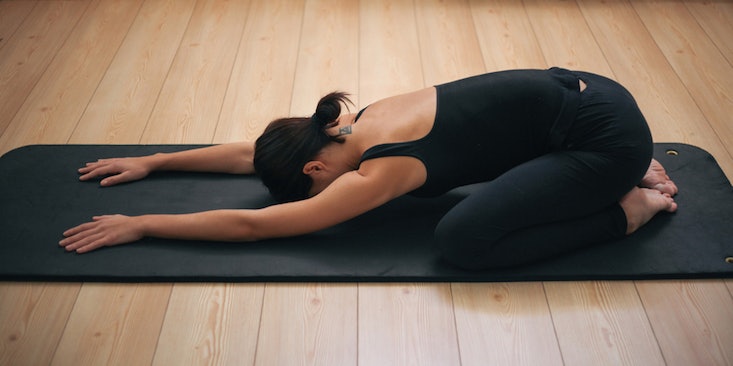

NUTRITIONAL SUPPORT FOR CHRONIC MIGRAINE SUFFERERS Close your eyes and relax your entire body.Rest arms away from your sides at a 30-degree angle with palms facing up.Lay on your back with legs and feet slightly apart and let feet fall out to the sides.You can end your yoga routine by lying down in this pose and relaxing.#5 CORPSE POSE – Rejuvenates the body by bringing it into a deep state of meditative rest. Hug your knees into your chest for a breath, then twist to the right on an exhale.Hold for 8 breaths, then draw your knees back to the center.Inhale, then exhale as you slowly lower your knees to the left side of your body.Cactus your arms out by your sides with your palms facing up and parallel your shins to your mat, bringing your knees to 90-degree angles.Lie on your back with your knees drawn in towards your chest.#4 SUPINE TWIST – Stretches the spine and relieves tension in the shoulders and back. Switch between the cat and cow poses a few times while taking long deep breaths and slow exhales.Breathe slowly and deeply while holding the pose for a couple of minutes.Tighten your abdomen while keeping your chin to your chest.Relax and hold the position for a few seconds.ĬOW: Exhale as you round your spine, drop your head, and tuck your chin (cat pose). Arch your back and keep your neck long.Inhale as you tilt your tailbone towards the sky, lowering your stomach towards the floor (cow pose).Center your hips over your knees and square your shoulders over your wrists.#3 CAT & COW – Improves blood circulation, relieves tension in the neck, shoulders, and upper back while increasing serotonin levels in the brain and relaxing the mind.ĬAT: Begin on your hands and knees (tabletop position). Reach your arms back along each side of your body, towards your feet, resting with your palms face up.Close your eyes and relax for a few seconds and don’t forget to breathe. Stretch your trunk and arms forward and rest your forehead on the floor as you lower your chest onto your thighs.Bring your legs all the way together, then sit your hips back onto your heels with your toes together, letting your knees spread apart wide,.Start on your hands and knees (tabletop position).#2 CHILD’S POSE – Calms down the nervous system, helps to increase the body’s parasympathetic state… decreasing stress and migraines.

Gently work the fingertips or palms towards the floor. Tuck the chin gently in towards the chest, lengthen the back of the neck.Standing with even weight through the feet, or weight very slightly forward onto the toes, keep the tailbone tucked under, allow the spine to bend forward.#1 STANDING FORWARD BEND – Invigorates the nervous system by increasing blood flow and calms the mind. When going through the sequence of yoga poses (asanas), hold each pose comfortably for a few minutes while concentrating on relaxing and breathing, inhaling and exhaling, slowly and deeply. Adding a cardiovascular activity such as walking or swimming and getting a good night’s sleep will help with reducing stress and is also very beneficial to migraine sufferers.Ħ YOGA POSES FOR MIGRAINE AND HEADACHE SUFFERERS Note: While yoga is effective and most doctors today advise you to take up this form of workout, when it comes to migraines or disorders, always consult your physician as yoga is not an alternative to your physician’s advice. Yoga, meditation, or a combination of the two is believed to reduce pain in people with arthritis, back pain, fibromyalgia, migraines, and other chronic conditions. If that’s not enough to get you started with yoga, it can help regulate your blood pressure and adrenal glands, lower your blood sugar, help you focus, relax overall and release tension in your limbs, help you sleep, and make you happy. Not only does it increase flexibility, improve your balance, build muscle strength, improve your posture, and prevent cartilage and joint breakdown, it also increases blood flow, drains your lymphs and boosts immunity. More and more people are catching on to the benefits of yoga. In addition to avoiding various triggers when possible such as stress, hormone fluctuations, sleep disturbances, certain types of food, excessive use of caffeine, addressing migraines nutritionally at the cellular level, and adding some healthy habits to your lifestyle such as yoga, can make all the difference. Migraineurs have lost many precious moments to pulsating pain, vertigo, aversion to light, and nausea to name just a few intolerable symptoms of migraine. It’s heartbreaking to see a friend or loved one suffer a migraine attack but only those who suffer migraines can truly understand how traumatic and debilitating they are.


 0 kommentar(er)
0 kommentar(er)
